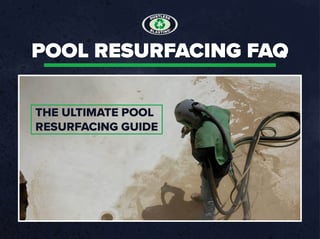
Dive into the fascinating world of pool restoration! Learn about the natural aging process that eventually calls for a little pool TLC; from plaster revival to a sparkling tile makeover, in this pool resurfacing guide.
As time goes by, plaster falters and tiles demand a makeover. In this blog post, we’ll answer some commonly asked questions about using a dustless blaster to resurface pools with answers that are both straightforward and reliable. By understanding why Dustless Blasting works well for this particular job, you’ll be better prepared to choose the right technique when renovating or restoring pools.
How much does it cost to resurface a pool?
A pool resurfacing project varies and typically depends on a number of factors like sq. ft. of a pool and the pool's coating like tile, paint or plaster. The cost can also vary depending on the complexity of the job. Other factors that may affect the price include the climate in your area, labor costs, and any special features you want included in your pool. On average, most pool owners can expect to spend $6,500 for a pool measuring 1,000 square feet.
How long does it take to resurface a pool?
A typical pool resurfacing project using traditional sanders and grinders can take anywhere from a few days to a few weeks, depending on the size and complexity of the job. Additionally, if you are having a more complex feature installed it may take longer to complete the project.
With Dustless Blasting equipment, you can expect shorter completion times, turning weeks into just mere hours! This is because Dustless Blasting utilizes a mixture of water and abrasive media to remove surface layers quickly and efficiently. In fact, plaster removal can be done in a single day, while pool tiles can be delicately cleaned of calcium buildup in as little as two hours.
What is the best abrasive media to use for pool restoration?
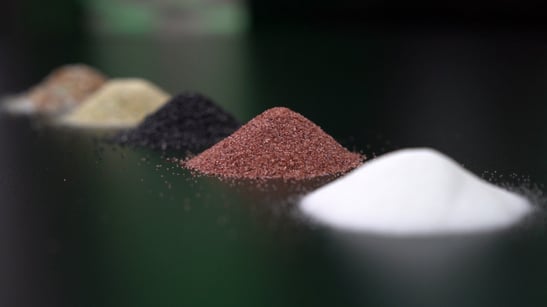
The best abrasive media to use for pool restoration depends on the material of your current surfaces. If you're looking to remove calcium buildup off your pool tiles, glass beads are the way to go. They not only leave the surface smooth but also prevent etching. However, for plaster removal, you'll need an angular abrasive like crushed glass. These are both eco-friendly and cost-effective abrasive media options that won't harm landscape or effect the PH.
Are there any cleanup tips after resurfacing a pool?
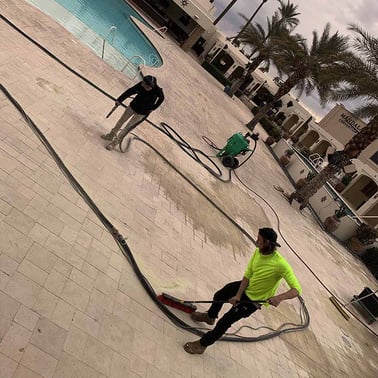
Once the pool project is complete, it’s important to remove the spent media and the blasted coating. Begin by vacuuming the bottom of the pool or using a push broom to gather the spent material and then properly dispose of it. We recommend purchasing a super sac that can hold up to 3,000 pounds of waste. Additionally, you should use an algaecide to treat your newly resurfaced surfaces as this will help prevent algae growth over time.
Will pool restoration affect nearby people?
The blasting method you choose will determine whether nearby residents and pedestrians are affected. Traditional dry sandblasting will generate dust and debris that can pose a hazard, so it's wise to keep children and pets away from the blasting area during the project. It's also important to note that in order to maintain a safe work environment, you need to make sure that people who are working in or near the pool area are wearing protective protective equipment (PPE) such as gloves and blasting suits – or a complete kit.
However, with the wet blasting method, you can rest assured that the process is virtually dust-free and eco-friendly, allowing for a safer and cleaner pool restoration project. This innovative technology uses a mixture of water and eco-friendly abrasive media to encapsulate and suppress dust particles, ensuring that there is minimal harm to the environment and nearby people.
Is pool restoration bad for the environment?
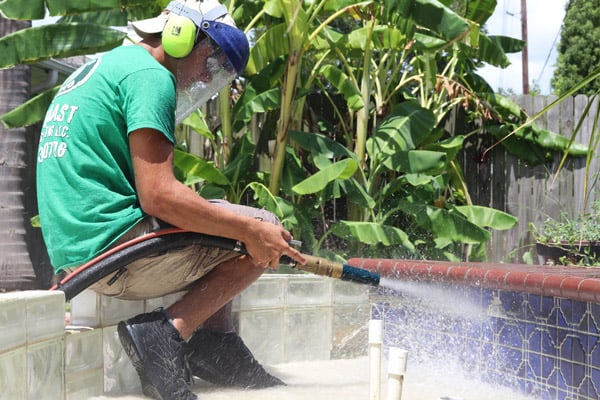
Pool restoration can have an impact on the environment, depending on the type of chemicals and materials used in the process. It is important to evaluate the potential environmental impacts of different restoration methods. However, Dustless Blasting equipment strips away the stress of harming the environment with its clean blasting method that promises a more efficient and effective resurfacing option. Unlike traditional sandblasting methods, Dustless Blasting keeps harmful particles from spreading into the atmosphere making it safe and easier to contain. You can rest easy knowing your impact on the environment is being diminished while producing stunning results.
Are there any safety precautions to consider during resurfacing?
Yes, safety is always important when it comes to pool restoration. Always wear gloves and protective eyewear while working in or around the pool. If you are suing any chemicals in the process, make sure to avoid skin contact and ensure that all debris is disposed of properly. Lastly, use caution when operating power tools and machinery as they can be hazardous if not used correctly.
If you're dry blasting, make sure to wear proper PPE - gloves, eye protection, hearing protection and a respirator.
How often should A pool Be resurfaced?
It is recommended that pools be resurfaced every 5-7 years, depending on the condition of the pool. For a fiberglass pool it can be every 15-30 years. Additionally, if you notice anything wrong with the surface, it may need to be addressed sooner. Regular maintenance and proper care can help extend the life of your pool’s surface. Be sure to consult a professional for more detailed advice.
Do I need special equipment for pool restoration?
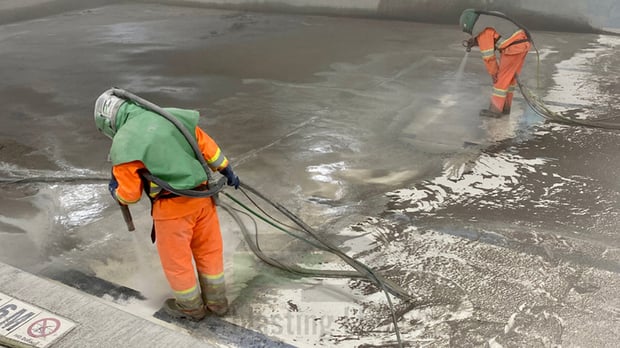
Yes, certain tools are necessary when restoring a pool. For example, you may need trowels, grout brushes and other materials to properly restore the surface. Additionally, power tools and machinery such as a dustless blaster may be required for more complex jobs. It is important to remember that all these items should be used safely and according to the instructions.
What are the benefits of resurfacing a pool?
Resurfacing a pool can offer a number of benefits, such as improving the overall appearance of the pool and creating a smoother surface for swimmers. Resurfacing can help protect the pool from damage caused by everyday use and wear and tear, extending its lifespan. It can also help to reduce chemical costs since the improved finish will help the pool retain its heat, allowing you to use less chemical treatments. All in all, resurfacing your pool can be a great way to get more use out of it for years to come!
Do I need to apply a sealant after resurfacing the pool?
It is always a good idea to apply a sealant after resurfacing the pool. This helps protect the surface of the pool and can help it last longer. Depending on the type of finish used, there are different types of sealants available like epoxy or silicone. Make sure to research what is best for your particular project before applying any sealant.
How can I tell if my pool needs resurfacing?
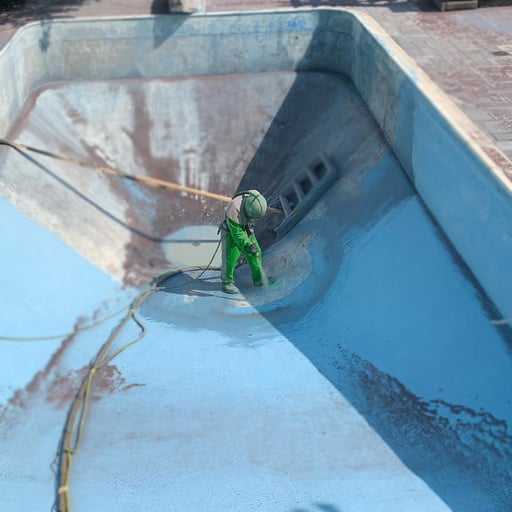
There are several signs that your pool may need resurfacing. The most common signs include discoloration, cracks, holes in the surface of the pool, and worn-out surfaces due to age or wear and tear. Additionally, if you notice that water is leaking from the pool or that it is not draining properly, these could be indications that your pool needs resurfacing. It is best to consult a professional if you are unsure whether your pool needs resurfacing or not.
What is the best time of year to resurface my pool?
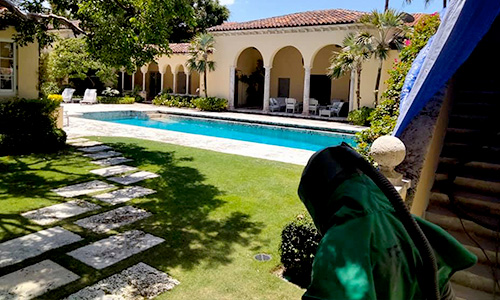
The best time of year to resurface your pool is during the spring and summer months, when temperatures are more moderate. This allows the sealant to dry properly and for the surface to be adequately prepared before applying the new coating. It is important to make sure that you keep an eye on weather conditions since heat and humidity can impact the drying time of sealants. It is also important to note that the surface must be completely dry before applying a new coating, so make sure to avoid resurfacing during periods of rain and snow.